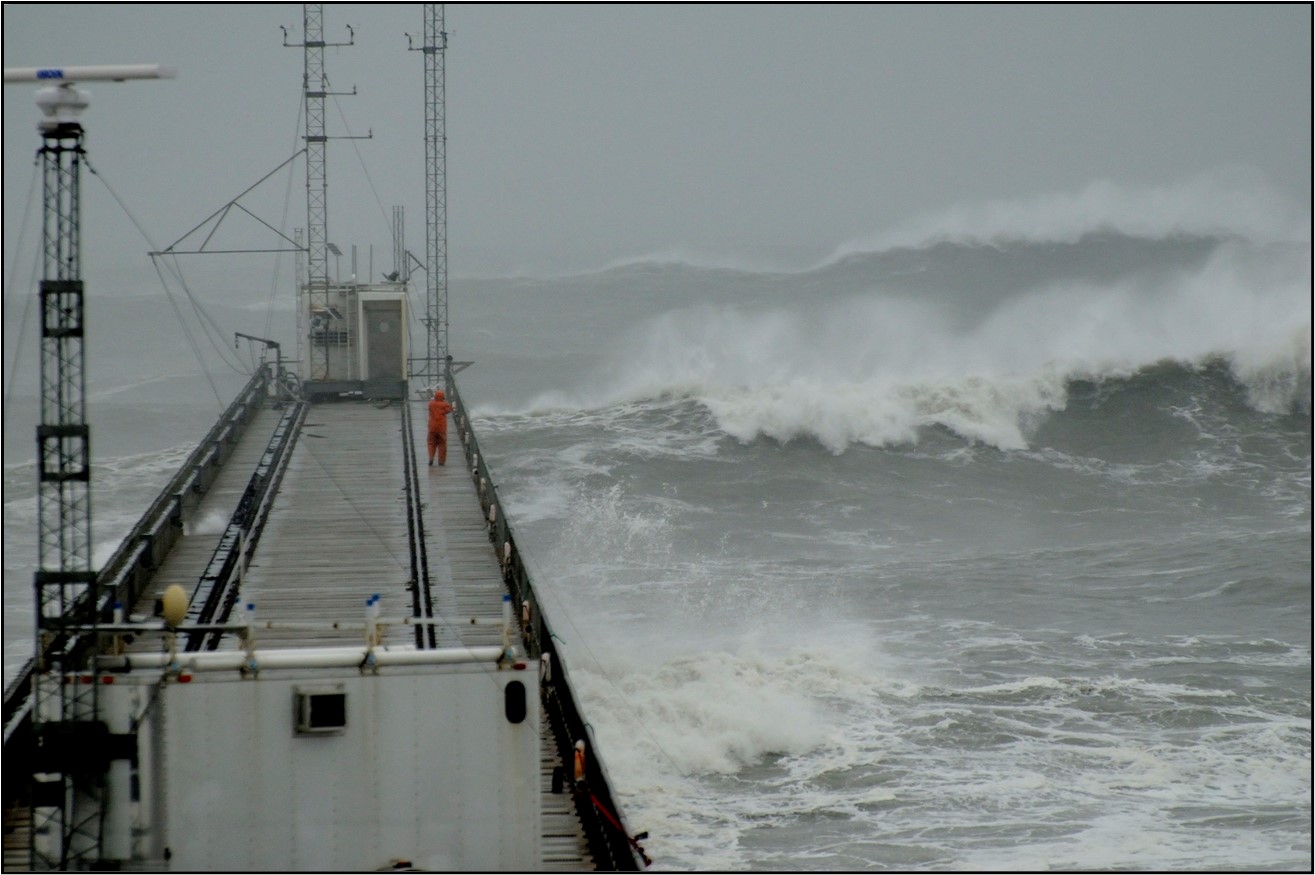Coastal Ocean Data System (CODS):
Wave Information Study Work Unit (WIS)
Product/Service/Capability
The objective of the Wave Information Study is to provide high-quality coastal wave hindcast model estimates, wave analyses products, and decision tools nationwide. Wave estimates are hindcast using high-quality wind fields, ice fields where appropriate, and the latest wave modeling technology. To satisfy the Corps requirement for risk-based designs, multi-decades of continuous and consistent wave estimates are required. Hindcast datasets provide hourly wave information for locations every few miles along the coast. The long-term hindcast wave data are accessible through a website for data analysis and downloads (https://wisportal.erdc.dren.mil).
Applications

Knowledge of the climatology of the atmosphere and waves is required for planning, design, construction, and maintenance of USACE projects in the coastal zone. Such information is scarce due to the lack of point source measurements at locations over time periods long enough to be statistically significant. This lack of information is a critical problem for USACE operations and project maintenance near the coast. To fill this need the WIS effort has been established to provide long-term (decades) of validated wave estimates along all US coasts including the Great Lakes and US territories.
Features
The WIS effort uses proven discrete spectral wave models and the best available input wind fields to produce wave estimates (height, wave period, and direction) and directional spectral estimates for pre-selection output locations along the coast. Extra-tropical (synoptic-scale meteorological systems) and tropical systems must be accurately defined in the wind field specification. Smaller scale events such as frontal passage with rapid wind shifts common to development of cyclogenesis also generate rapidly increasing wave conditions. These conditions must be adequately estimated temporally and spatially where the scales can extend into 1000’s of kilometers and over multi-decadal duration of the hindcast. The large-scale basins (Atlantic, Pacific, Gulf of Mexico and Western Alaska) use one technique and wind field specification (Swail, et al. 2006, Cox and Swail 2001). The Great Lakes domain uses the Coastal Forecast System Reanalysis (CFSR, Saha, et al. 2010). Details of these wind field methodologies are found on the WIS website. In arctic regions (the Great Lakes and Alaska) the spatial and temporal evolution (and decay) of shore-fast ice, and for the Alaskan waters the migration of northern ice packs, must be accurately estimated and implemented. Lastly, the temporally-varying wave fields consist of multiple wave systems, with local wind-seas developing from local meteorological events, interlaced with wave energy derived from distant events comprised of long-period swells.
It is imperative for WIS to evaluate the modeled estimates with field wave measurements (point-source and satellite based remote sensing systems, e.g., altimeters, synthetic aperture radars). The evaluation process extends over the large spatial range, wave climate regimes, and meteorological events. WIS is expanding the evaluation procedures, using new variants of statistical tests, and analyses for long-term consistencies and potential errors used in the Quality Control and Quality Assurances of WIS.

The generation of long-term wave climatology has to retain uniformity and consistency in the wind field specification, modeling technology, grids, and model resolutions over the duration of the hindcast effort. This reduces the potential for discontinuities in the modeled wave estimates over time. Wind fields for WIS are derived from one source, and the methodology creating these wind fields is consistent over a day, year, or decade. If, for example new techniques become available, tests are performed to determine if there is an introduction of a false signal in the wind field specification. If there is, the entire data base of winds must be reprocessed. This also holds true for the wave modeling technology. WIS has migrated toward 3rd Generation wave models (e.g. WAM, Komen et al 1994, Wavewatch III™, WW3DG, 2019; Tolman, 2014, SWAN, The SWAN Team, 2014). For any domain (e.g. Atlantic, Gulf of Mexico, Pacific, etc.) WIS performs forensic testing of the modeling suite to assess model performance. The selection procedure is based on these tests and the model is selected. The web-based results are based on one unique format independent of what model used. WIS staff is in direct communication with the developers of the modeling technologies and has access to the most recent version. In addition, WIS continues to assess new technologies and will move to new technology if the results demonstrate an overall improvement to the existing WIS estimates for a specific domain.

At the present time, WIS has completed a full update of the Atlantic and Pacific Oceans, the Gulf of Mexico, Western Alaska, and all five Great Lakes. The update for these regions has been performed to include the period from about 1980 through near present (generally <1 year behind). It is the WIS intent to produce these incremental updates on a yearly basis. The long-term goals of WIS will be to perform extreme storm event analyses for all of the major domains, extending throughout the hindcast period. This will increase the storm event population to over 40 years, reducing the uncertainty within extreme storm analyses.
The results of all WIS hindcasts are accessible directly from the CHL Data Thredds Server (https://chldata.erdc.dren.mil) or the WIS portal (https://wisportal.erdc.dren.mil). In the latter case, the time series of wind and integral wave properties (height, period, and direction) are posted along with analysis tools that enable the user to generate output products (tabular and/or graphical form). It is anticipated the number of analysis tools will increase over time and based on user requirements.
Status
| Region | Availability |
|---|---|
| Great Lakes | 1979 - 2024 |
| Gulf of Mexico | 1980 - 2024 |
| Western Alaska | 1985 - 2024 |
| Atlantic Ocean | 1980 - 2024 |
| Pacific Ocean | 1980 - 2024 |
| S. California* | 1988 - 2024 |
| *94xxx stations from 1980-1987 were removed due to issues with location. | |
In addition to the yearly WIS hindcast update, testing of the new ERA5 wind fields, (Hersbach et al., 2019), will be performed to determine potential improvements in the resulting wave estimates. As ERA5 wind fields are an order of magnitude finer resolution in space and six-fold increase in time resolution than the present WIS wind field specifications, it is anticipated there will be an improvement in wave estimates. The outcome of these tests will be a first step envisioned for the future of WIS.
Data Portal
The new WIS Data Portal was launched in 2022. The new system provides many advantages over the previous system.
- Added Capabilities in FY23
- Dynamic production of Mean Max and Extremes Analysis tables and plots with the latest estimates.
- Dynamic extractions of 2D spectra for user-specified ranges of time.
- Tool to extract 2D spectra forcing files for model input for WIS Stations**.
**Available model forcing is initially for CMS-Wave only and was funded by the CIRP research program. Capacity for additional models can be added in future funded efforts.
- Additional Improvements Coming in Q2/Q3 FY26. More details to come.
Related Links
- Direct link to WIS Portal
- WIS Portal API Information
- WIS Station Information (number, lat, lon, depth, domain)
Documentation and References
A list of all WIS related reports, published journal articles, and presentations can be found at: https://wis.erdc.dren.mil/wis_publications.html
- Cox, A.T. and V.R. Swail. (2001). A global wave hindcast over the period 1958-1997: validation and climate assessment, J. Geophy. Res., Vol. 106, No. C2, pp. 2313-2329.
- Cox, A.T., J.A. Greenwood, V.J. Cardone and V.R. Swail, (1995). “An interactive objective kinematic analysis system” 4th International Workshop on Wave Hindcasting and Forecasting, October 16-20, 1995, Banff, Alberta.
- Hanson, J. L., and O. M. Phillips, (2001): Automated analysis of ocean surface directional wave spectra. J. Atmos. Oceanic. Technol., 18, 277-293.
- Hersbach et al., (2019), The ERA5 global reanalysis, Q J R Meteorol Soc., 146:1999–2049.
- Jensen, R.E., M.A. Cialone, R.S. Chapman, B.A. Ebersole, M. Anderson, and L. Thomas, (2012). “Lake Michigan Storm: wave and water level modeling,” Great lakes Coastal Flood Study, 2012 Federal Inter-Agency Initiative, ERDC/CHL, TR-12-26, US Army Engineer Research and Development Center, Vicksburg, MS.
- Jensen, R.E., V.J. Cardone and A.T. Cox, (2006). “Performance of third generation wave models in extreme hurricanes,” 9th International Wave Hindcast and Forecast Workshop, September 25-29, Victoria, BC.
- Jensen, R., N. Schneffer, S.J. Smith, D. Webb, and B. Ebersole. (2002). “Engineering studies in support of Delong Mountain Terminal Project,” ERDC/CHL, TR-02-26, US Army Engineer Research and Development Center, Vicksburg, MS.
- Komen, G.J, L. Cavaleri, M. Donelan, K. Hasselmann, S. Hasselmann, and P.A.E.M. Jassen, (1994). “Dynamics and modeling of ocean waves,” Cambridge University Press.
- Saha, S.S., et al. (2010). “The NCEP Climate Forecast System Reanalysis,” Bull. Amer. Meteor. Soc., 91, 1015-1057.
- Swail, V.R., V.J. Cardone, M. Ferguson, D.J. Gummer, E.L. Harris, E.A. Orelup, and A.T. Cox, (2006). “The MSC50 wind and wave reanalysis,” 9th International Wave Hindcast and Forecast Workshop, September 25-29, Victoria, BC.
- Swail, V.R. and A.T. Cox, (2000). “On the use of NCEP/NCAR reanalysis surface marine wind fields for a long term North Atlantic wave hindcast,” J. Atmos. Ocean. Technol., 17, 532-545.
- The SWAN Team (2014). SWAN scientific and technical documentation SWAN Cycle III version 41.01, Delft university of Technology, The Netherlands.
- Tolman, H. L., (2014). User manual and system documentation of WAVEWATCH III version 4.18. NOAA / NWS / NCEP / MMAB Technical Note 316, 194 pp.+ Appendices.
- Tracy, B., E. Devaliere, J. Hanson, and H. Tolman, (2007). “Wind sea and swell delineation for numerical wave modeling,” 10th International Wave Hindcast and Forecast Workshop, 11-16 November, Oahu, HA.
- The WAVEWATCH III Development Group (WW3DG) (2019): User manual and system documentation of WAVEWATCH III R version 6.07. Tech. Note 333, NOAA/NWS/NCEP/MMAB, College Park, MD, USA, 465 pp. +Appendices. https://raw.githubusercontent.com/wiki/NOAA-EMC/WW3/files/manual.pdf.
- USACE Wave Information Study: 2021 Annual Update, ERDC/CHL CHETN-I-xx, US Army Engineer Research and Development Center, Vicksburg, MS. https://dx.doi.org/10.21079/11681/48731
Points of Contact
| Team Lead: | Catie Dillon |
| WIS Team Members: | Dr. Tyler Hesser, Dr. Ali Abdolali, Dr. Tripp Collins, Mitchell Brown, Dr. Robert Jensen (emeritus) |
| Program Manager: | Jessamin A. Straub |
| E-Mail: | WISinfo@usace.army.mil |



 Home
Home
 Project Overview
Project Overview WIS Portal
WIS Portal
 Publications
Publications Updates
Updates

 Contact Us
Contact Us